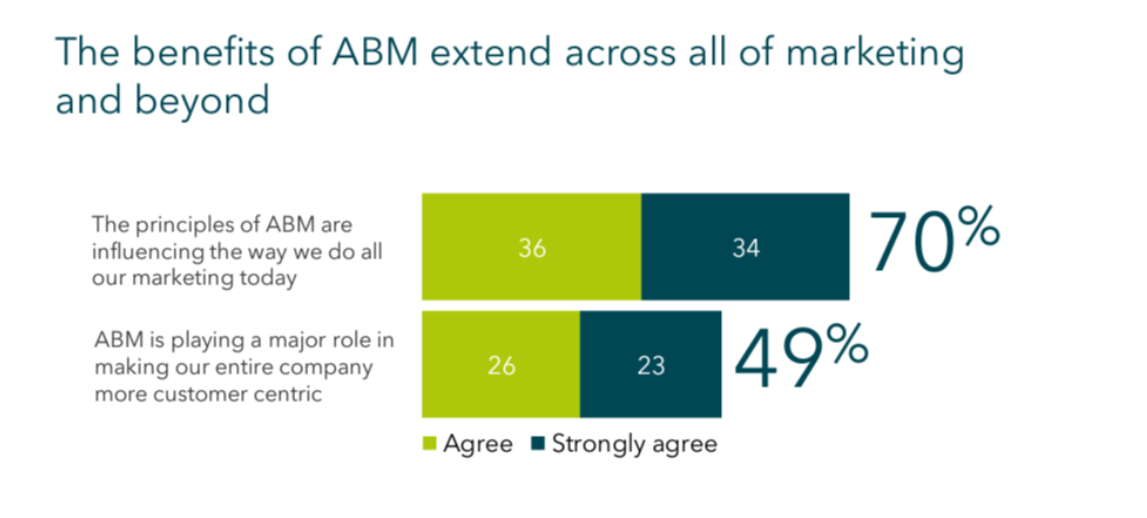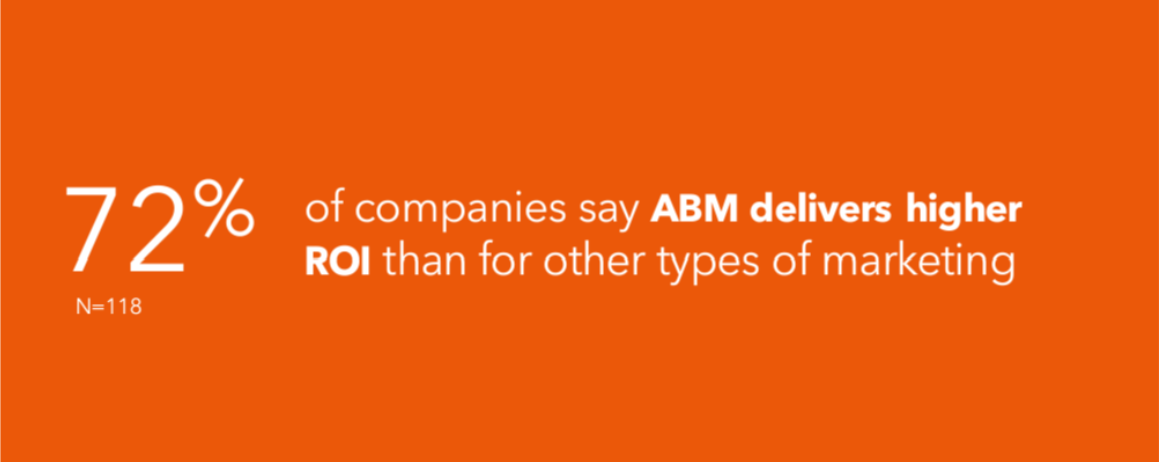Search volume for Account-Based Marketing, better known as ABM, has essentially doubled in the past 5 years.
One of the primary reasons interest in ABM has skyrocketed (which we shared last year) is simple: ABM delivers results.
But what kind of results are Marketers actually seeing? What’s the true impact they’re experiencing? Where should others expect to see ABM’s impact on their business?
In Embedding ABM: Next Steps for Market Leadership—ITSMA and the ABM Leadership Alliance’s fifth annual ABM benchmark study—you’ll learn about the current state of ABM and the five ways that ABM leaders stand apart to generate more substantial results.
Let’s dive into their findings.
The Growing Influence of ABM
ABM is increasingly becoming “business as usual” within B2B Marketing.
This statement isn’t merely an educated guess, either, as 70% of respondents agreed that the principles of ABM are influencing the way that Marketing is currently conducted.
Beyond the way Marketing is managed, ABM is also changing the way businesses treat their customers. 23% of all respondents (49% total) stated that ABM is playing a major role in making their entire company more customer-centric—an augmentation that is bound to benefit all parties.
As one respondent shared, their company’s entire focus now is to become as account-based as they possibly can. “Our CEO and CMO believe that the more personalized we can get with our customers, the better,” they said. “With our long history and legacy customers, there’s still so much opportunity to expand.”
How ABM Compares to Other Types of Marketing
In conducting the study, authors Rob Leavitt (Senior Vice President, Consulting) and Julie Schwartz, (Senior Vice President, Research and Thought Leadership) found that 72% of companies said that ABM delivers greater ROI than any other form of Marketing.
Considering that 76% of respondents in last year’s study reported that ABM’s ROI was Somewhat Higher (with 26% saying Significantly higher) than traditional Marketing initiatives, this is a slight drop from the previous year. While it’s a key indicator of performance, ROI isn’t always the best measure of success for any initiative, however.
65% of Marketers reported improved revenue from their ABM programs, a full 10% increase YOY. Rounding out the Three R’s of Business Impact, Marketers reported a 3% gain in Relationships (73%) and a 6% gain in Reputation/Brand (40%).
Whichever way you choose to slice it, ABM programs are clearly paying off for B2B Marketers.
Mature ABM Programs Drive Better Results
What’s also clear is how much better mature ABM programs are at driving results.
With the increased interest in ABM in the past five years or so, it’s not surprising we’re reaching a stage in the greater B2B Marketing landscape where ABM programs have become fully integrated.
As the study reports, nearly half of all respondents (45%) reported their ABM efforts are maturing quite nicely. Programs in the Expanding category increased 12% YOY, while those in the Exploring category dropped 18%. (Essentially, programs in the Expanding and Embedded categories are the more mature approaches, while Exploring and Experimenting represent those just beginning their ABM journeys.)
But simply saying that your program is maturing doesn’t mean much. The proof is in the pudding, and boy is that pudding delicious. Those in the Expanding and Embedded categories shared that they’d seen a 53% bump in pipeline growth and a 43% improvement in revenue.
Clearly, there is a correlation between program age and program success. But simply existing for a number of years doesn’t pre-qualify you for better outcomes. So what does?
The 5 Things Leading ABM Programs Do Differently
In 2021, 33% of ABM leaders saw a significant improvement in their overall business results, buoyed by a remarkable 84% improvement in measurable business revenue.
In order to help more ABM programs reach these heights, ITSMA uncovered five distinct areas where leading ABM programs stand apart from the rest.
Leading ABM programs are more likely to:
Be Strategically Aligned
- These programs featured more inclusive, diverse, senior leaders in ABM strategy and governance
Better Collaborate with Sales
- Those working more closely with sales at every stage of program management and customer relationship development yielded better outcomes
Better Develop Staff
- These programs were far more likely to employ professionals with a wide range of ABM competencies with a high degree of proficiency
Excel in Process
- Programs that have invested more in strengthening and solidifying essential tools, templates, and processes have seen greater results
Leverage Technology and Data
- Those programs which take advantage of the capabilities of their existing tech stack and use them to their fullest potential saw terrific results
Conversely, what leading ABM programs don’t do is just as interesting as what they are doing.
ABM leaders do not:
- Spend more money on ABM
- Use different types of ABM
- Use different Marketing tactics
- Use a different approach to staffing
By focusing on all of the details, they’re squeezing everything possible out of each individual insight, thus enabling them to achieve a greater yield from every account. Basically, ABM leaders aren’t using major ad dollars, swarms of employees, or revolutionary techniques to surpass their peers. Instead, they’re using everything at their (and likely your) disposal to outperform the competition.
Why Stakeholder Support is Key to Success
Each of the five elements above is critical to evolving any ABM program. But having strategic support from the top is almost equally important, specifically within the C-Suite.
“We have two ABM executive sponsors,” one respondent said, “our chief Marketing officer and our chief revenue officer. The sales, service, and customer success organizations report to the chief revenue officer. It also helps that both customer Marketing and account-based Marketing are huge priorities for the CEO. That’s why we get the support and resources we need.”
As the study shares, ABM programs need stability in the form of guaranteed, upfront budgets. While other Marketing tactics can take an ad hoc approach, ABM requires immediate funding in order to feed the necessary relationship-building it requires. Knowing this makes it clear why a champion in the C-Suite is needed. Without it, any ABM program won’t be able to flourish.
Learn How to Make Your ABM Program Stand Out from the Pack
This is just a taste of everything that’s been packed into this terrific report.
Beyond the findings we’ve highlighted in this blog, there are more than two dozen additional insights that will help you fuel your ABM program.
As a member of the ABMLA, we sincerely hope you enjoy it and find some truly impactful and actionable data. Here’s to even greater ABM success in 2022!
Download your copy of Embedding ABM today.




